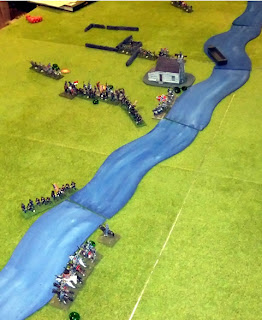Ah, something Historical; it's been a while, and so it was great to play something without the intrusion of wizards!
Spring, 1862 and in the quiet mid-western valley of the Waranoq river Colonel Hawkins thought he had little to concern himself with at the strategically important but largely silent Rumford Ferry crossing.
His forces were limited, but deemed sufficient; 4 companies of the 19th Massachussets Regiment, a Pair of Parrot cannon and a troop of the Wisconsin Rangers. As dawn rose, one company held piquet duty at the ferry crossing whilst the Rangers were out on forage duty and the gunners prepared their guns. All seemed like it would be every day for the last few months.
But no, it was with some consternation that Hawkins received news from Captain Witherspoon's company at the river that in the night the ferry had been stolen away to the far shore. It seemed unlikely, but it was soon apparent that the enemy had night marched, perhaps with scouts to steal the ferry too, and was within sight of the opposite shore...
Indeed, a small brigade of Confederate troops, under the command of Brigadier Emmet Theosiphus Ingrams had arrived in the area, with orders to seize the crossing, and Ingrams had indeed used his most able scouts to steal away the ferry. And in doing so the men had determined the water level and flow of the river was gentle enough to allow men to cross on foot as well.
With two Regiments of South Carolinan Infantry and a Squardron of a notorious Cavalry unit known as the South Carolina Tigers, Ingrams made a swift advance covered by darkness and woodland, arriving at the river at first light. They quickly embarked a company of infantry onto the ferry, whilst another company led the crossing of the river, wading out into the icy spring melt waters.
Hawkins hurried to raise the rest of his troops from their slumber whilst the piquet under Witherspoon held its ground as best it could. Their steady rifle fire proved out of effective range, but was enough to sow confusion in the Confederate on the Ferry, who withdrew in some confusion. Still there was little they could do to stop the drenched, but aggressive South Carolinans under Ingrams junior commander, Easterman. Or the similarly enthused Tigers.
Still, the Tigers found themselves outgunned by the recently roused Union infantry. and were soon forced back accross the river.
The 4th Southern Carolinans meanwhile began to encircle the increasingly beleaguered skirmisher of Witherspoons 2nd company. The Ferry was now covered from fire and Ingrams troops began to cross the river with dry boots and more importantly, powder.
At this point the Wisconsin Rangers returned to the field, and began a hell-for-leather charge on a company of the South Carolinans.
But the Carolinans were able to meet the charge, not the Northern cavalry's strong suit. And although suffering a few casualties, with the leadership of Easterman, a rebel yell and cold steel they were able to drive off the Rangers.
By now the piquet under Witherspoon had been dispersed, faced as it was by entire regiment. But it had allowed enough time for Hawkins to bring up the guns and two companies of the 19th Mass. These formed a defensive line, and were able to put superior fire into the Rebels.
The Carolinans charged the guns, with a degree of overconfidence that actually proved well founded; the guns did their work, but not quickly or brutally enough and were caught and destroyed. Bouyed up by this the centre of the Rebel lines also charged.
At the same point the Carolina Rangers, who had spent around an hour South of the River rallying their numbers, turned and made their way accross the river again. the isolated third company of the Union infantry tried to hold their attack, as their friends tried to stay the Rebel infantry, but for Hawkins the tide was turning against him.
In the centre a bloody melee left both companies engaged in an appaling state, no longer fit as fighting units, but this only served to leave one Union company to face a regiment and a half of Confederate troops. Seeing the Tigers put the Laconic 3rd Company to flight to his rear, Hawkins was only too ready to accept terms of surrender when offered by Ingrams, at a little after ten in the morning.
Union losses amounted to 34 dead and 85 wounded, mostly in the centre, with some 130 fit men also taken prisoner out of an initial force of some 700. Confederate losses amounted to 27 dead and 63 wounded; which secured the key crossing for relatively light losses (from a force of just over 1200 men) and also garnered them a valuable supplty of arms and equipment. Not to mention another medal for Ingrams increasingly gaudy uniform.
----
a quick Black Powder game, which took me and Martin about 90 minutes to play through. In terms of special features, the ferry could put one company per turn across the river, and was assumed to be ready to do the same again on the next turn. Crossing the river on foot incurred a -1 penalty to all shooting for the rest of the game.
The three Union companies in the camp were assumed to be asleep; their general had to issue wake up orders, which got one base out and ready for action for each success, no Brigade orders were permitted for this. This mean't that it took at least two turns for a company to be fully ready to move, though if attacked they could defend themselves in-situ at a depleted level of ability. The Union cavalry arrived on their turn 5.
A nice little challenge; as it was I think the dice did much to beat Martin (usually my excuse). That of course means I won!
Snippets #34
2 hours ago











No comments:
Post a Comment